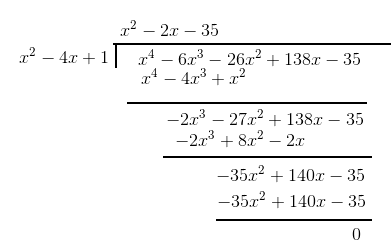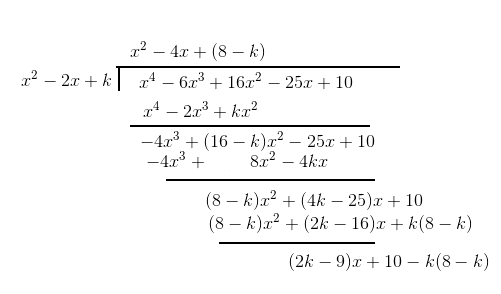NCERT Solutions for Exercise 2.4 Class 10 Maths Chapter 2 - Polynomials
CBSE Class 10th Exam Date:01 Jan' 26 - 14 Feb' 26
NCERT Solutions For Class 10 Maths Chapter 2 Exercise 2.4 Polynomials
NCERT Solutions for class 10 maths ex 2.4 Polynomials is discussed here. These NCERT solutions are created by subject matter expert at Careers360 considering the latest syllabus and pattern of CBSE 2023-24. This class 10 ex 2.4 deals with polynomial and its types, algebraic expressions, degree of a polynomial expression, graphical representation of the polynomial equations, factorization, relationship between zeroes and coefficient of a polynomial.
Mathematically, the number of terms and the degree of the polynomial, polynomial can be classified into many types. Based on the number of terms, polynomials are classified as Monomial, Binomial and Trinomial. Also based on Degree, polynomials are classified as Linear Polynomial, Quadratic polynomial and Cubic Polynomial. Along with the Class 10 Maths chapter, 2 exercise 2.4 the following exercises are also present. Students should practice all problems discussed in these exercises to command the concepts.
Access Exercise 2.4 Class 10 Maths Answers
Polynomials Class 10 Maths Chapter 2 Excercise: 2.4
Q1 (1) Verify that the numbers given alongside the cubic polynomials below are their zeroes.
Also verify the relationship between the zeroes and the coefficients in each case:
$2x^3 + x^2 - 5x +2 ; \frac{1}{2} , 1 , -2$
Answer:
p(x) = 2x 3 + x 2 -5x + 2
$\\p(\frac{1}{2})=2\times \left ( \frac{1}{2} \right )^{3}+\left ( \frac{1}{2} \right )^{2}-5\times \frac{1}{2}+2\\ p(\frac{1}{2})=\frac{1}{4}+\frac{1}{4}-\frac{5}{2}+2\\ p(\frac{1}{2})=0$
p(1) = 2 x 1 3 + 1 2 - 5 x 1 + 2
p(1) =2 + 1 - 5 + 2
p(1) = 0
p(-2) = 2 x (-2) 3 + (-2) 2 - 5 x (-2) +2
p(-2) = -16 + 4 + 10 + 2
p(-2) = 0
Therefore the numbers given alongside the polynomial are its zeroes
Verification of relationship between the zeroes and the coefficients
Comparing the given polynomial with ax 3 + bx 2 + cx + d, we have
a = 2, b = 1, c = -5, d = 2
The roots are $\alpha ,\beta \ and\ \gamma$
$\\\alpha=\frac{1}{2}\\ \beta =1\\ \gamma =-2$
$\\\alpha+\beta +\gamma \\ =\frac{1}{2}+1+(-2)\\ =-\frac{1}{2}\\ =-\frac{b}{a}$
Verified
$\\\alpha\beta +\beta \gamma +\gamma \alpha \\ =\frac{1}{2}\times 1+1\times (-2)+(-2)\times \frac{1}{2}\\ =\frac{-5}{2}\\ =\frac{c}{a}$
Verified
$\\\alpha\beta\gamma \\=\frac{1}{2}\times 1\times -2\\ =-1 \\=-\frac{2}{2}\\ =-\frac{d}{a}$
Verified
$x ^ 3- 4x ^ 2 + 5x - 2 ; 2,1,1$
Answer:
p(x) = x 3 - 4x 2 + 5x - 2
p(2) = 2 3 - 4 x 2 2 + 5 x 2 - 2
p(2) = 8 - 16 + 10 - 2
p(-2) = 0
p(1) = 1 3 - 4 x 1 2 + 5 x 1 - 2
p(1) = 1 - 4 + 5 - 2
p(1) = 0
Therefore the numbers given alongside the polynomial are its zeroes
Verification of relationship between the zeroes and the coefficients
Comparing the given polynomial with ax 3 + bx 2 + cx + d, we have
a = 1, b = -4, c = 5, d = -2
The roots are $\alpha ,\beta \ and\ \gamma$
$\\\alpha=2\\ \beta =1\\ \gamma =1$
$\\\alpha+\beta +\gamma \\ =2+1+1\\ =4\\ =-\frac{-4}{1}\\=-\frac{b}{a}$
Verified
$\\\alpha\beta +\beta \gamma +\gamma \alpha \\ =2\times 1+1\times 1+1\times 2\\ =5\\ =\frac{5}{1}\\ =\frac{c}{a}$
Verified
$\\\alpha\beta\gamma \\=2\times 1\times 1\\=2 \\=-\frac{-2}{1}\\=-\frac{d}{a}$
Verified
Answer: Let the roots of the polynomial be $\alpha ,\beta \ and\ \gamma$
$\\\alpha +\beta +\gamma =2\\ \alpha \beta +\beta \gamma +\gamma \alpha =-7\\ \alpha \beta \gamma =-14$
$\\x^{3}-(\alpha +\beta +\gamma )x^{2}+(\alpha \beta +\beta \gamma +\gamma \alpha)x-\alpha \beta \gamma =0\\ x^{3}-2x^{2}-7x+14=0$
Hence the required cubic polynomial is x 3 - 2x 2 - 7x + 14 = 0
Q3 If the zeroes of the polynomial $x^3 - 3 x^2+ x +1$ are a – b, a, a + b, find a and b.
Answer:
$x^3 - 3 x^2+ x +1$
The roots of the above polynomial are a, a - b and a + b
Sum of the roots of the given plynomial = 3
a + (a - b) + (a + b) = 3
3a = 3
a = 1
The roots are therefore 1, 1 - b and 1 + b
Product of the roots of the given polynomial = -1
1 x (1 - b) x (1 + b) = - 1
1 - b 2 = -1
b 2 - 2 = 0
$b=\pm \sqrt{2}$
Therefore a = 1 and $b=\pm \sqrt{2}$ .
Answer: Given the two zeroes are
$2+\sqrt{3}\ and\ 2-\sqrt{3}$
therefore the factors are
$[x-(2+\sqrt{3})]\ and[x-(\ 2-\sqrt{3})]$
We have to find the remaining two factors. To find the remaining two factors we have to divide the polynomial with the product of the above factors
$[x-(2+\sqrt{3})]\[x-(\ 2-\sqrt{3})]=x^2-(2+\sqrt{3})x-(\ 2-\sqrt{3})x+(\ 2+\sqrt{3})(\ 2-\sqrt{3})\\=x^2-2x-\sqrt{3}x-2x+\sqrt{3}x+1\\=x^2-4x+1$
Now carrying out the polynomial division

Now we get $x^2-2x -35 \ is \ also \ a\ factor$
$\\x^2-2x -35 =x^2-7x+5x-35\\=x(x-7)+5(x-7)\\=(x-7)(x+5)$
So the zeroes are $2+\sqrt{3}\ ,\ 2-\sqrt{3},7\ and\ -5$
Answer: The polynomial division is carried out as follows

Given the remainder =x+a
The obtained remainder after division is $(2k-9)x+10-k(8-k)$
now equating the coefficient of x
$2k-9=1$
which gives the value of $k=5$
now equating the constants
$a=10-k(8-k)=10-5(8-5)=-5$
Therefore k=5 and a=-5
More About NCERT Solutions for Class 10 Maths Exercise 2.4:
Exercise 2.4 Class 10 Maths – consists of five problems in this section each containing a few sub-questions. In exercise 2.4 Class 10 Maths question 1 has two subsections where we need to check and demonstrate the relationship between the zeroes and the coefficients in each case. The remaining questions also support the zeros of a polynomial. And the last sum is based on the concept of division of a polynomial. The NCERT solutions for Class 10 Maths exercise 2.4 mainly focused on the zeroes of the polynomial, the relationship between the zeroes, the coefficients of the polynomial and the Division Algorithm. Two questions related to the division algorithm are given in exercise 2.4 Class 10 Maths.
Benefits of NCERT Solutions for Class 10 Maths Exercise 2.4
- NCERT solutions for Class 10 Maths exercise 2.4 helps in solving and revising all questions of these exercises.
- If you go through the NCERT solution for Class 10th Maths chapter 2 exercise 2.4, you will be able to get more marks if you practice it thoroughly.
- Exercise 2.4 Class 10 Maths, is based on zeroes of the polynomial, the relationship between the zeroes, the coefficients of the polynomial and the division Algorithm which are important concepts of the chapter. also find Polynomials class 10 Notes here and use these notes to revise all the concepts discussed in this chapter.
Also see-
NCERT Solutions of Class 10 Subject Wise
Subject Wise NCERT Exemplar Solutions
Frequently Asked Questions (FAQs)
This ex 2.4 class 10 discussed concepts of terms, degrees and exponents in a polynomial. Practice the problems discussed in it to command the concepts. as per the above problem:
Terms : 6x^2, 5x, 18
Degree : 2
Exponents : 2 and 1
The class 10 maths ex 2.4 explains the concepts related to quadratic polynomial. A quadratic polynomial is nothing but a polynomial with degree two. The general form of a quadratic polynomial is ax^2 + bx + c = 0 where a, b, c are real numbers
The concepts related to quadratic polynomial are discussed in class 10 ex 2.4. Practice the problems discussed in this exercise to command these concepts. as per this problem the maximum index here is 2 . Also it is in the form of ax^2 + bx + c = 0.
Therefore 5x^2 + 6x + 54 = 0 is a quadratic polynomial.
n^2 - 10n + 24 = n^2 - 4n - 6n + 24
= n(n - 4) - 6(n - 4)
= (n - 4)(n - 6)
The number 9 can be written as 9x^0 which is a polynomial. Therefore 9 is a polynomial.
If p(x) and g(x) are any two polynomials where g(x) ≠ 0, p(x) = g(x) × q(x) + r(x).
That is Dividend = Divisor × Quotient + Remainder
NCERT solutions for Class 10 Maths chapter 2 exercise 2.4 consists of five problems and the questions are based on the concept of the division algorithm, to verify and prove the relationship between the zeroes, the coefficients and the zeros of a polynomial.
Questions related to CBSE Class 10th
On Question asked by student community
Good Morning, candidate,
The question papers will be available soon at the link attached herewith. You can keep an eye on the website of careers360. it will provide you perfect pattern of question papers, which will improve your writing skills and practice learning.
https://school.careers360.com/articles/cbse-sahodaya-class-10-pre-board- question-paper-2025-26
Thank you.
Hello,
You can download subject wise CBSE Sahodaya Class 10 Pre-Board Question Paper 2025-26 for Round 1 & Round 2 from this link : CBSE Sahodaya Class 10 Pre-Board Question Paper 2025-26
Hope it helps !
Hello there,
Solving question papers is one of the best method of preparation. It gives you proper idea about the exam pattern and important topics to cover.
Here is the link attached from the official website of Careers360 which will provide you with the CBSE Sahodaya question papers. Hope it helps!
https://school.careers360.com/articles/sahodaya-question-paper-2025
thank you!
The CBSE Class 10 Hindi Question Paper Blueprint (Marking Pattern) for the 2025-2026 Board Exam is divided into four main sections, with a total of 80 marks for the written exam. The structure is slightly different for Hindi Course A and Hindi Course B.You can download the official Sample Question Paper (SQP) and its Marking Scheme for both Hindi Course A and Course B here: https://school.careers360.com/boards/cbse/cbse-class-10-hindi-sample-papers-2025-26
The CBSE Sahodaya Question Papers for Class 10 (2025-26) are not released centrally by the board as a single PDF.
Here is the essential information you need:
-
Local Release: The papers are designed and released by the individual Sahodaya School Clusters (groups of CBSE schools) just before or during the pre-board exam dates (typically held in December and January). Therefore, you must check your local cluster's portal or directly with your school administration.
-
Best Practice: The official model papers, based on the full 2026 syllabus, are the most reliable tool for practice. These accurately reflect the structure, format, and competency-based questions used in the Sahodaya exams.
You can download the latest CBSE Class 10 Model Papers to simulate the Sahodaya tests here: https://school.careers360.com/articles/sahodaya-question-paper-2025 . Focus on that pattern
Applications for Admissions are open.
As per latest syllabus. Physics formulas, equations, & laws of class 11 & 12th chapters
JEE Main Important Chemistry formulas
Get nowAs per latest syllabus. Chemistry formulas, equations, & laws of class 11 & 12th chapters
JEE Main high scoring chapters and topics
Get nowAs per latest 2024 syllabus. Study 40% syllabus and score upto 100% marks in JEE
JEE Main Important Mathematics Formulas
Get nowAs per latest syllabus. Maths formulas, equations, & theorems of class 11 & 12th chapters
